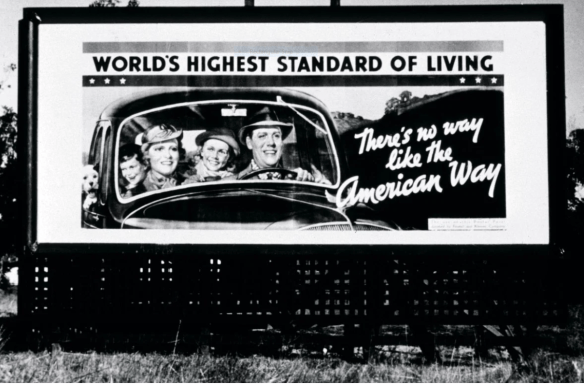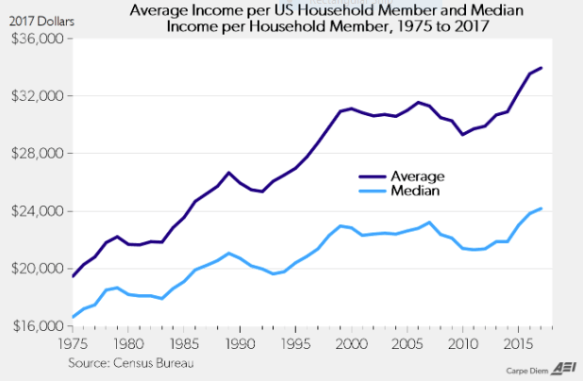There is a common myth today, often stated in the media, that the U.S. middle class is stagnant and even in decline. According to this myth today’s middle class families have a lower standard of living than middle class families headed by our parents or grandparents in the mid-twentieth century.

This often repeated story is simply wrong. The following chart, based on the latest census report, shows that the middle class is only shrinking in the sense that the upper middle class is growing so rapidly. Likewise, the percentage of low-income families is shrinking because so many low-income families are moving up to middle income.

Consider the additional charts derived from the same census data:
- While median family income (adjusted for inflation) is steadily increasing, average household size is steadily decreasing.

- This means that the median income per household member is increasing even faster.

- Real median family income for U.S. married couples with both spouses working full time is growing amazingly fast. (Hey guys, get married and encourage your wife to work too!)

- What income inequality? The share of total income earned by the top 5% and top 20% of U.S. households has hardly changed in the past 25 years.

Summary. The middle class is only disappearing in the sense that middle income households are gradually moving up into a higher income group. The share of U.S. households earning more than $100,000 (in 2018 dollars) has more than tripled since 1967. Likewise the share of households earning $35,000 or less (in 2018 dollars) has greatly diminished. If you want to steadily increase your income, what you need to do is get educated, get married, and both you and your spouse work. It’s shouldn’t be that difficult to figure out.

The real problem is our nation’s decline in social mobility from within the low-income category. The likelihood of growing-up in a family surviving within low-income circumstances and subsequently living in a middle-income category when 40 years of age has declined substantially in the last 30 years. The pockets of entrenched poverty throughout our nation have devastating effects on the HEALTH and welfare of the affected adults and their children. The character of these Families, their Extended Family, their Family Traditions, and their supportive micro-social networks conspire by the instability of their caring relationships to subvert the best of intentions. The ecology and culture of their wider community too often add to the underlying chaos. Our nation lacks an awareness that one answer/strategy will not solve the entrenched poverty that limits the social mobility of too many citizens. In addition, many of our nation’s serious health problems are deeply connected with these locally unique neighborhoods of entrenched poverty. Think adolescent suicide/homicide, homelessness, mass shootings, and substance abuse mortality.
The point of this data is that social mobility is, in fact, increasing, not declining. That said, of course we should strive to do even better and almost certainly will do better in the future. Progress is slow but steady. Things are getting much better over time. We are constantly bombarded by bad news but we need to keep it in perspective.
I am not sure that the data imply that social mobility is improving. What it demonstrates is that income is increasing concentrated within 5% of our nation’s citizens, especial its highest 1%. The decline in social mobility is especially onerous for a small segments of our nation’s citizens. I’ll look to the data and report back.
See “the NBER digest” January 2019 issue, especially “Long-term effects of Children’s Neighborhood Environs” Raj Chetty has published many studies at the National Bureau of Economic Research.
Chetty is undoubtedly pointing out specific situations where improvements can be made and that is very worthwhile. But the second chart above shows that there is a gradual but persistent shift from lower income status to higher income status across the board. This is the big picture which we should always keep in mind even as we focus on ways to improve even more.
Social Mobility has a few attributes not shared by the findings you cite. The Brookings Institute produced a more nuanced report, largely from the studies of Chetty. It can be easily found with a standard internet search.
Please edit my content to include ‘2018″ for the Brookings report.
I’m checking out the work on social mobility by Chetty on the Brookings website and will respond soon.